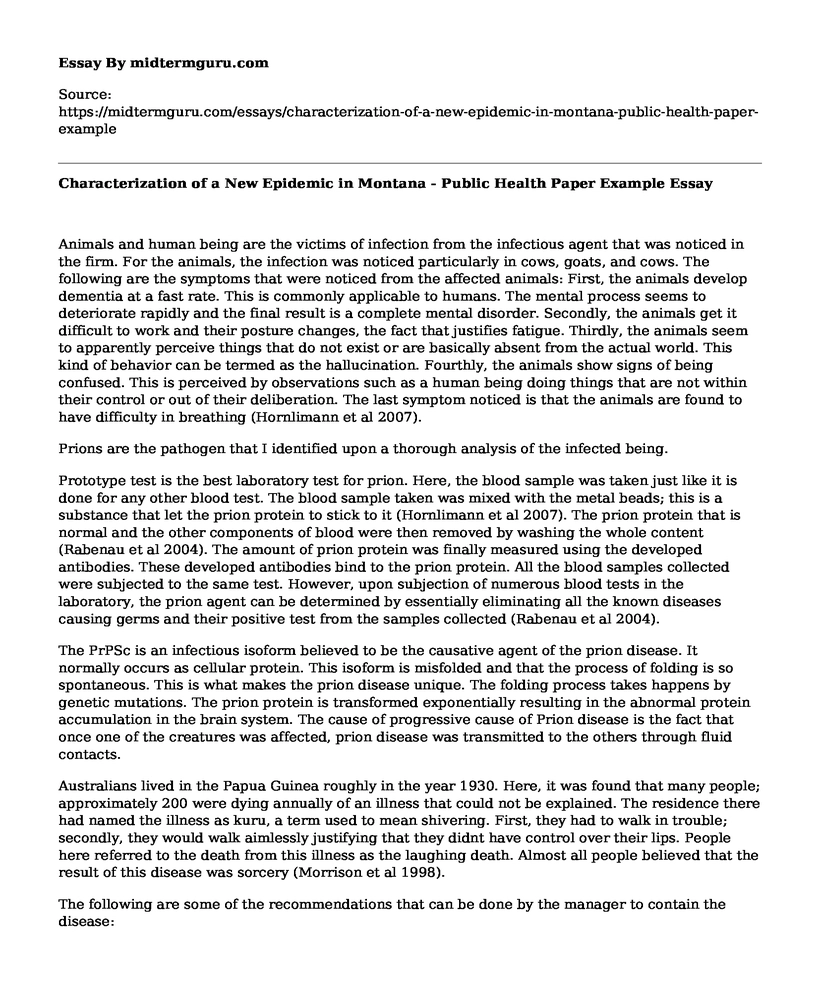Animals and human being are the victims of infection from the infectious agent that was noticed in the firm. For the animals, the infection was noticed particularly in cows, goats, and cows. The following are the symptoms that were noticed from the affected animals: First, the animals develop dementia at a fast rate. This is commonly applicable to humans. The mental process seems to deteriorate rapidly and the final result is a complete mental disorder. Secondly, the animals get it difficult to work and their posture changes, the fact that justifies fatigue. Thirdly, the animals seem to apparently perceive things that do not exist or are basically absent from the actual world. This kind of behavior can be termed as the hallucination. Fourthly, the animals show signs of being confused. This is perceived by observations such as a human being doing things that are not within their control or out of their deliberation. The last symptom noticed is that the animals are found to have difficulty in breathing (Hornlimann et al 2007).
Prions are the pathogen that I identified upon a thorough analysis of the infected being.
Prototype test is the best laboratory test for prion. Here, the blood sample was taken just like it is done for any other blood test. The blood sample taken was mixed with the metal beads; this is a substance that let the prion protein to stick to it (Hornlimann et al 2007). The prion protein that is normal and the other components of blood were then removed by washing the whole content (Rabenau et al 2004). The amount of prion protein was finally measured using the developed antibodies. These developed antibodies bind to the prion protein. All the blood samples collected were subjected to the same test. However, upon subjection of numerous blood tests in the laboratory, the prion agent can be determined by essentially eliminating all the known diseases causing germs and their positive test from the samples collected (Rabenau et al 2004).
The PrPSc is an infectious isoform believed to be the causative agent of the prion disease. It normally occurs as cellular protein. This isoform is misfolded and that the process of folding is so spontaneous. This is what makes the prion disease unique. The folding process takes happens by genetic mutations. The prion protein is transformed exponentially resulting in the abnormal protein accumulation in the brain system. The cause of progressive cause of Prion disease is the fact that once one of the creatures was affected, prion disease was transmitted to the others through fluid contacts.
Australians lived in the Papua Guinea roughly in the year 1930. Here, it was found that many people; approximately 200 were dying annually of an illness that could not be explained. The residence there had named the illness as kuru, a term used to mean shivering. First, they had to walk in trouble; secondly, they would walk aimlessly justifying that they didnt have control over their lips. People here referred to the death from this illness as the laughing death. Almost all people believed that the result of this disease was sorcery (Morrison et al 1998).
The following are some of the recommendations that can be done by the manager to contain the disease:
Manage the case, once the case has been reported, the manager has to employ measures that will ensure that the infected are quickly serviced and the uninfected are protected against infection.
Identifying the potential cause of infection; once the disease has been managed, the potential source ought to be determined to ensure that further cause of the infection is controlled.
Manage the potentially exposed persons; once the disease has started its way, it is likely that the other people who seem uninfected are in potentially viable for the infection too.
Evaluate the environment; this is critical in the sense that the disease is likely to spread cutting over all parts due to the fact that the disease is transmittable.
References
Hornlimann, B., Riesner, D., & Kretzschmar, H. A. (2007). Prions in humans and animals. Berlin: Walter de Gruyter.
Morrison, D. R., North Atlantic Treaty Organization, & NATO Advanced Research Workshop on Prions and Brain Diseases in Animals and Humans. (1998). Prions and brain diseases in animals and humans. New York: Plenum Press, in cooperation with NATO Scientific Affairs Division.
Rabenau, H. F., Cinatl, J., & Doerr, H. W. (2004). Prions: A challenge for science, medicine, and the public health system. Basel: Karger.
Cite this page
Characterization of a New Epidemic in Montana - Public Health Paper Example. (2021, Jun 01). Retrieved from https://midtermguru.com/essays/characterization-of-a-new-epidemic-in-montana-public-health-paper-example
If you are the original author of this essay and no longer wish to have it published on the midtermguru.com website, please click below to request its removal:
- Public Health Paper Sample: HIV Phases
- Annotated Bibliography on Road Safety Measures - Paper Example
- Essay on Child Foster Care and Types of Child Maltreatment
- Paper Example on Peplau's Theory of Interpersonal Relations
- The Plight of the Foster Care Children of Georgia - Paper Example
- Alzheimer's: Progression of Symptoms & Related Factors - Essay Sample
- Early Prediction of Spontaneous Patent Ductus Arteriosus (PDA) Closure and PDA Associated Outcomes







